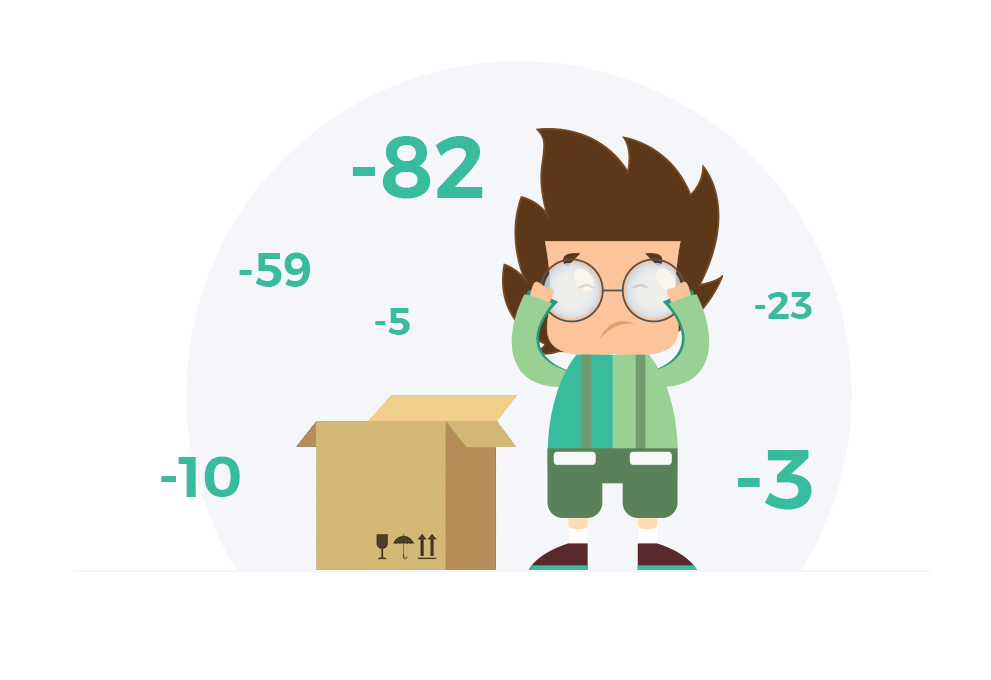Negative Inventory: Restore your Stock Back into a Positive State
Come on, let’s break that ghost inventory!
A manufacturer can’t afford to make any mistakes or run the risk of making mistakes while simultaneously trying to fulfill their production and sales deadlines because there are so many processes to follow.
Negative inventory is a problem that will crop up frequently enough, according to many manufacturers, that you might as well accept it. But the sad fact is that it’s an indication of poor management. For this reason, we’ve looked at negative inventory and how to spot it in your systems and get rid of it.
But the longer you wait to address your negative inventory issues, the longer you’ll be basing your company judgments on false information.
But don’t be alarmed! We studied the issue of negative inventory and wrote an essay on how to recognize and deal with your negative inventory.
What is a Negative Inventory?
When a manufacturer inventory count indicates that is below zero, this is known as negative inventory (or Occasionally Ghost Inventory)
Whatever the causes, having negative stock in your inventory is a very prevalent issue in the manufacturing sector, and some businesses even use it as a legitimate business strategy.
However, by accepting negative stock, you run the risk of causing worse issues for your company, mostly because you will be placing needless orders for more resources or commencing production because of inaccurate information.
Additionally, if you let negative stock build up in your inventory, you will always run the risk of:
- Selling products to customers even while the store is empty
- Selling products to clients online without having stock
- Transferring stock without having enough of it
- Purchasing additional materials even when some are currently being produced
But being aware of the problems is one thing. Being proactive and figuring out what causes negative stock is the best approach to prevent it.
Effects of Negative Inventory on Business
How significant are difficulties with negative inventory? The next order for the item has a probability of being incorrect or unable to be fulfilled. When a customer places an order for an item that is out of stock, they will be disappointed.
They will have to wait till your inventory is replenished once more. People dislike waiting, especially when they can frequently obtain goods from your rivals in just a few days.
Numerous problems can occur, and you will discover that they might have a horrible impact on your company operations, your revenue, and the confidence of your client. Therefore, you should take action to ensure that you can either prevent these problems from occurring or that, in case they do, you can immediately fix them.
What Causes Negative Inventory?
You are now fully informed regarding negative inventory. Finding the source of the bad stock is the next stage. Negative inventory may happen as a result of:
1- Timing
When examining what constitutes negative inventory, this is perhaps the situation that occurs the most frequently. A timing problem could occur when a customer orders a product that is out of stock, but you go ahead and label the order as shipped because you know the product’s manufacture will shortly be finished.
This problem is probably the simplest to resolve because you can alter your inventory after production is finished
2- Production
You must take into account byproducts, scrap levels, production statistics, and batch tracking during production. manufacturing either not enough or too many products can result from misunderstanding your manufacturing orders or mistakenly making a duplicate.
3- Inventory in Various Places
When sending goods to the incorrect warehouse or recording a sale from the incorrect retailer, these things can happen.
This negative inventory problem is concerning because, if the stock transfer is saved incorrectly, it may appear that Warehouse A is missing 200 products while Warehouse B has 200 more than it requires.
4- A Negative Item Stocks
In order to update your existing inventory levels, backflushing is the process of creating and finishing a manufacturing order (MO) after a batch production has been completed. Alternately, if there is a product that you want to create to order (MTO) only when there is demand, an item-level negative stock may arise.
How to repair the negative inventory
Considering how easy negative stock can form, it could appear that rectifying negative inventory is a difficult procedure.
Nevertheless, we are delighted to provide you some solace by informing you that rectifying negative inventory is rather simple. Especially when you know what you’re looking for.
All you have to do is find which products or materials are showing stock levels below zero in your inventory management system reports.
The corrections you’ll need to make, though, will all rely on the kind of negative inventory you recorded:
Time – It’s crucial to not inflate your amount while rectifying, such as when shipping a product before production is complete, and to keep in mind that any missing inventory is still in your stock.
Location – The inventory may be in the correct location if you entered the erroneous values when recording a stock transfer. It simply needs to be taken into account appropriately.
Negative stock at the item level – This could be a severe issue because it might point to a fault with your manufacturing procedure. You must figure out why your resources or goods are entering as negative stock throughout production.
However, we recognize that this is still rather nebulous, and we are unable to provide more details given that manufacturers employ a wide range of inventory control systems.
Also Read: Avoid the Top 5 Inventory Management Problems, and Improve Your Inventory Practices
What Are the Consequences of Failing to Correct Negative Inventory?
- If your cost of goods sold (COGS) is off, your revenues and losses will also be off.
- If your company’s inventory decreased on the income statement, the working capital would increase since your current assets equal your current liabilities.
- Your income and expense reports may have errors in your accounts payable (AP) bills for your inventory purchases.
- Your balance sheet contains an incorrect inventory quantity.
- You’ll have an unbalanced Cash-basis Balance Sheet.
- Your vendor reports contain mistakes.
Updating your manufacturing ERP software and streamlining your management procedures are your best bets for preventing negative inventory.
How Can the Problems with Negative Inventory Be Reduced?
Several best practices that we have discovered to be quite helpful in dealing with negative inventory include:
– Monitoring
One such strategy is the 4-point stock validation strategy, where we compare the total Stock On Hand (SOH) between 4 entities, including what the supplier’s mechanical team is seeing, what the supplier’s IT team is reporting, what the franchisee’s merchandising team is seeing, and what the franchisee’s IT team is sending (referring to a Supplier- Franchisee model where inventory position is daily sent to the supplier through Electronic Data Interchange (EDI) based on which stock is automatically deployed).
– Examine and streamline the business process
The process deficiencies that can result in instances of negative inventory are frequently found and fixed with the help of ongoing analysis of business operations.
Selling the incorrect SKUs by manually entering the incorrect SKU number or scanning a different barcode in the event that the POS does not recognize the SKU is one regular occurrence in a business. By creating Dump SKUs for various categories, selling such SKUs can be done by scanning the dump SKU barcode and applying a price override. This will make sure that the inventory system receives only SKU information that has been verified.
Final Thoughts
Are you ready to implement a state-of-the-art order proccessing solution to ensure an efficient inventory management system and avoid the pitfalls of negative inventory? If the answer is yes, do schedule a demo at a date and time of your choosing, to see how this works and how we can help you increase your overall efficiency and productivity. Our New Solutions will be happy to provide a detailed explanation of all the features and answer any questions you may have.
By using New G Solution, you will
- Control your inventory management system and stock levels across platforms and marketplaces.
- Powerful pricing services will provide you control over your B2B business.
- Monitor your items across several locations and storage facilities.
- Maintain a serials log.
- Control your RMA.











Recent Comments